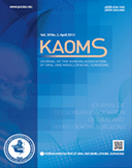Journal of the Korean Association of Oral and Maxillofacial Surgeons
- P-ISSN2234-7550
- E-ISSN2234-5930
- SCOPUS, KCI, ESCI
 ISSN : 2234-7550
ISSN : 2234-7550
Retrospective study on change in pharyngeal airway space and hyoid bone position after mandibular setback surgery
Min Woo Han (Gumdan Top General Hospital)
Doo Yeon Hwang (Ajou University School of Medicine)
Seung Il Song (Ajou University School of Medicine)
Abstract
Objectives: The purpose of this study was to evaluate changes in the pharyngeal airway space and hyoid bone position after mandibular setback sur-gery with bilateral sagittal split ramus osteotomy (BSSRO) and to analyze the correlation between the amount of mandibular setback and the amount of change in pharyngeal airway space or hyoid bone position. Materials and Methods: From January 2010 to February 2013, a total of 30 patients who were diagnosed with skeletal class III malocclusion and underwent the same surgery (BSSRO) and fixationmethod in the Division of Oral and Maxillofacial Surgery, Department of Dentistry at the Ajou University School of Medicine (Suwon, Korea) were included in this study. Lateral cephalograms of the 30 patients were assessed preoperatively (T1), immediately postoperatively (T2), and 6 months postoperatively (T3) to investigate the significanceof changes by time and the correlation between the amount of mandibular setback and the amount of change in the airway space and hyoid bone position. Results: Three regions of the nasopharynx, oropharynx, and hypopharynx were measured and only the oropharynx showed a statistically significantdecrease (P<0.01). A significantposterior and inferior displacement of the hyoid bone was found 6 months after surgery (P<0.01). Analysis of the cor-relation between the amount of mandibular setback and the amount of finalchange in the airway space and hyoid bone position with Pearson’s correla-tion showed no significant correlation.Conclusion: In this study, the oropharynx significantlydecreased after mandibular setback surgery, and changes in the surrounding structures were identifiedthrough posteroinferior movement of the hyoid bone during long-term follow-up. Therefore, postoperative obstructive sleep apnea should be considered in patients who plan to undergo mandibular setback surgery, and necessary modifications to the treatment plan should alsobe considered.
- keywords
- Mandibular setback surgery, Pharyngeal airway space, Hyoid bone position, Obstructive sleep apnea
- Downloaded
- Viewed
- 0KCI Citations
- 0WOS Citations